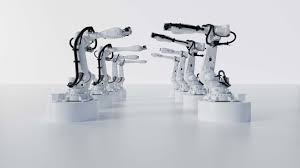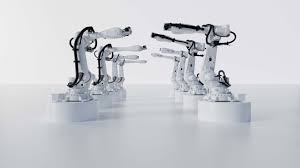
During the first half of the current year, a record number of robots were purchased by North American firms even as the companies struggled to keep factories and warehouses running because of an extremely tight labor market and increased compensation costs.
According to data compiled by the Association for Advancing Automation, companies ordered a record 12,305 machines worth $585 million in the second quarter, 25 per cent more than in the same period a year ago. The North American robotics market had its best first half ever, thanks to a strong first quarter, according to the group.
"Companies need to get product out the door — and so they need" new automation, said Jeff Burnstein, president of the Association for Advancing Automation, known as A3.
Eaton Corporation PLC, for example, is planning 150 different robot installations in its North American electrical equipment factories over the next year and a half.
In the current tight labor market, the incentives for companies to pursue a robot-enhanced workforce are obvious. Employers are bidding up wages because there are nearly two open jobs for every unemployed worker: Total labor costs in the United States increased 5.1% year on year in the second quarter, the most since the Labor Department began tracking them in 2001.
However, if robots are intended to increase worker productivity, this has not yet been demonstrated.
Those thick order books come as the United States' productivity fell at the fastest annualized rate since the government began tracking it in 1948.
One possible explanation is the COVID-19 pandemic's distortions. The crisis caused massive shifts in the workforce, including an exodus of workers during the worst days of the crisis who are only now slowly returning to work. It is normal for employees to be less productive when transitioning into new careers or changing jobs within their current fields.
Furthermore, much of the recent job growth has come from lower-productivity service sectors like leisure and hospitality, which may obscure any gains made by robots elsewhere.
According to A3's Burnstein, it also takes time for businesses to fully implement new machinery in order to maximize its potential. "There will be a learning curve," he admitted.
This is especially true in industries that are embracing entirely new technologies, such as the automotive industry's shift toward electric vehicles. A3 discovered that nearly 60 per cent of the robots ordered in the second quarter went to automakers.
Mike Cicco, CEO of FANUC America, the Japanese robotics manufacturer's U.S. division, estimates that half of his industry's sales to carmakers are currently earmarked for new electric-vehicle factories.
"This is all investment for plants that won’t be up and running for several years now," he said, so it is not surprising that those robots are not yet contributing to higher productivity.
The hurry to include robots is part of a larger investment surge as businesses try to keep up with strong demand, which has remained high even as the Federal Reserve has raised interest rates to combat inflation.
Knapheide Manufacturing Co is one of the companies investing in new robots, with a new production line for flatbed truck bodies set to open this year in its Quincy, Illinois, facility. Robots will feed steel parts through an automated welding process on the new line.
The engineer in charge of the installation, Mike Bovee, believes the new robots will help alleviate a chronic shortage of welders. Knapheide is currently hiring workers from as far away as Texas.
"We’ll always need as many welders as we can find," he said, but they can be redeployed to other parts of production at the 1,500-worker plant.
(Source:www.reuters.com)
According to data compiled by the Association for Advancing Automation, companies ordered a record 12,305 machines worth $585 million in the second quarter, 25 per cent more than in the same period a year ago. The North American robotics market had its best first half ever, thanks to a strong first quarter, according to the group.
"Companies need to get product out the door — and so they need" new automation, said Jeff Burnstein, president of the Association for Advancing Automation, known as A3.
Eaton Corporation PLC, for example, is planning 150 different robot installations in its North American electrical equipment factories over the next year and a half.
In the current tight labor market, the incentives for companies to pursue a robot-enhanced workforce are obvious. Employers are bidding up wages because there are nearly two open jobs for every unemployed worker: Total labor costs in the United States increased 5.1% year on year in the second quarter, the most since the Labor Department began tracking them in 2001.
However, if robots are intended to increase worker productivity, this has not yet been demonstrated.
Those thick order books come as the United States' productivity fell at the fastest annualized rate since the government began tracking it in 1948.
One possible explanation is the COVID-19 pandemic's distortions. The crisis caused massive shifts in the workforce, including an exodus of workers during the worst days of the crisis who are only now slowly returning to work. It is normal for employees to be less productive when transitioning into new careers or changing jobs within their current fields.
Furthermore, much of the recent job growth has come from lower-productivity service sectors like leisure and hospitality, which may obscure any gains made by robots elsewhere.
According to A3's Burnstein, it also takes time for businesses to fully implement new machinery in order to maximize its potential. "There will be a learning curve," he admitted.
This is especially true in industries that are embracing entirely new technologies, such as the automotive industry's shift toward electric vehicles. A3 discovered that nearly 60 per cent of the robots ordered in the second quarter went to automakers.
Mike Cicco, CEO of FANUC America, the Japanese robotics manufacturer's U.S. division, estimates that half of his industry's sales to carmakers are currently earmarked for new electric-vehicle factories.
"This is all investment for plants that won’t be up and running for several years now," he said, so it is not surprising that those robots are not yet contributing to higher productivity.
The hurry to include robots is part of a larger investment surge as businesses try to keep up with strong demand, which has remained high even as the Federal Reserve has raised interest rates to combat inflation.
Knapheide Manufacturing Co is one of the companies investing in new robots, with a new production line for flatbed truck bodies set to open this year in its Quincy, Illinois, facility. Robots will feed steel parts through an automated welding process on the new line.
The engineer in charge of the installation, Mike Bovee, believes the new robots will help alleviate a chronic shortage of welders. Knapheide is currently hiring workers from as far away as Texas.
"We’ll always need as many welders as we can find," he said, but they can be redeployed to other parts of production at the 1,500-worker plant.
(Source:www.reuters.com)





